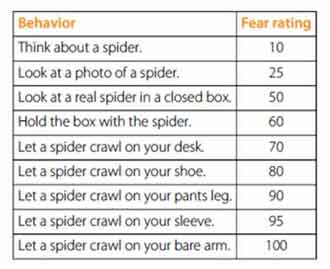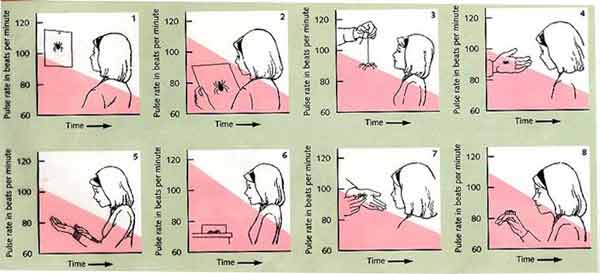On This Page:
Systematic desensitization is a type of exposure therapy based on the principle of classical conditioning. Wolpe developed it during the 1950s to treat phobias and anxiety disorders.
It involves gradually exposing the individual to the feared object or situation in a controlled and relaxed environment. The process combines relaxation techniques with a hierarchical exposure to the anxiety-causing stimulus, allowing the individual to confront and reduce their fear without an anxiety response gradually.
This therapy aims to gradually remove the fear response of a phobia and substitute a relaxation response to the conditional stimulus using counter-conditioning.
The patient is counterconditioned, taught a new association that is to counter the original behavior learnt. The new response they learn is relaxation instead of fear (being mindful) because fear and relaxation cannot coexist (reciprocal inhibition).
A desensitization hierarchy is constructed, and the patient works through it, visualizing each anxiety-provoking event while engaging in the relaxation response.
The number of sessions required depends on the severity of the phobia. Usually, 4-6 sessions, up to 12 for a severe phobia. The therapy is complete once the agreed therapeutic goals are met (not necessarily when the person’s fears have been completely removed).
How Desensitization Works
- In vitro – the client imagines exposure to the phobic stimulus.
- In vivo – the client is actually exposed to the phobic stimulus.
Research has found that in vivo techniques are more successful than in vitro (Menzies & Clarke, 1993). However, there may be practical reasons why in vitro may be used.
There are three phases to the treatment:
Systematic desensitization involves a three-step process:
- Relaxation Training: The individual learns deep muscle relaxation techniques and breathing exercises to control anxiety and physical reactions to stress. This step is very important because of reciprocal inhibition, where, once the response is inhibited because it is incompatible with another. In the case of phobias, fears involve tension, and tension is incompatible with relaxation.
- Establishment of Anxiety Hierarchy: The individual and therapist collaboratively create a list of fear-inducing situations related to the specific phobia, ranking them from least anxiety-provoking to most. The list is crucial as it provides a structure for the therapy.

- Gradual Exposure: Starting with the least anxiety-inducing situation, the individual is exposed to each item while employing relaxation techniques. They move up the hierarchy only when they can remain relaxed at the current level. Over time, this exposure in a relaxed state diminishes the anxiety response to the feared stimulus. The client repeatedly imagines (or is confronted by) this situation until it fails to evoke any anxiety, indicating that the therapy has succeeded.
Examples
Applying the three-step process of systematic desensitization to treating a phobia of spiders:
-
Relaxation Training:
- The individual is first taught relaxation techniques, such as deep breathing, progressive muscle relaxation, or guided imagery.
- They practice these techniques until they can achieve a relaxed state consistently on command.
-
Establishment of Anxiety Hierarchy:
- Together with the therapist, the individual creates a list of situations involving spiders, ranked from least anxiety-provoking to most.
- This might look like:
- Thinking about a spider.
- Looking at a picture of a spider.
- Watching a video of a spider.
- Being in the same room as a spider inside a closed container.
- Watching someone else handle a spider.
- Standing close to a spider inside an open container.
- Touching a spider with a gloved hand.
- Holding a spider with bare hands.
-
Gradual Exposure:
- The client reaches a state of deep relaxation and is then asked to imagine (or is confronted by) the least threatening situation in the anxiety hierarchy.
- For example, in a relaxed state, the individual first thinks about a spider. The focus here is on maintaining relaxation despite the thought.
- Once they can think about spiders without anxiety, they move to the next level, like looking at a picture of a spider while staying relaxed.
- The process continues, with the individual gradually exposed to more direct interactions with spiders while maintaining their calm, until they can eventually handle a spider without significant fear.
Throughout the process, the goal is for the individual to associate spiders with feelings of relaxation rather than fear, eventually diminishing the phobic response.

Application
Wolpe (1964) successfully used the method to treat an 18-year-old male with a severe handwashing compulsion. The disorder involved a fear of contaminating others with urine.
After urinating, the patient felt compelled to spend 45 minutes cleaning his genitalia, two hours washing his hands, and four hours showering.
Treatment involved placing the young man in a state of relaxation and then asking him to imagine low-anxiety scenes (such as an unknown man touching a trough of water containing one drop of urine).
As the patient’s anxiety gradually dissipated, Wolpe gradually increased the imaginary concentration of urine.
In addition, a real bottle of urine was presented at a distance and moved closer to the patient in gradual steps.
Finally, Wolpe could apply drops of diluted urine to the back of the patient’s hand without evoking anxiety. A follow-up four years later revealed complete remission of the compulsive behaviors.
Mary Cover-Jones studied several children to investigate the best way to remove fear responses in children.
Critical Evaluation
Practical Issues
The fact that the systematic desensitization technique can be applied to images means that many of the practical disadvantages involved in vivo exposition with this type of phobia can be eliminated.
One weakness of in vitro exposition is that it relies on the client’s ability to be able to imagine the fearful situation. Some people cannot create a vivid image, and thus systematic desensitization is not always effective (there are individual differences).
Systematic desensitization is a slow process, taking 6-8 sessions on average. Although, research suggests that the longer the technique takes, the more effective it is.
The progressive structure of systematic desensitization allows the patient to control the steps he/she must make until fear is overcome. This absence of disturbing elements makes this technique less likely to provoke abandonment of the therapy.
Theoretical Issues
Systematic desensitization is highly effective where the problem is learned anxiety of specific objects/situations, e.g., phobias (McGrath et al., 1990). However, systematic desensitization is not effective in treating serious mental disorders like depression and schizophrenia.
Studies have shown that neither relaxation nor hierarchies are necessary and that the important factor is just exposure to the feared object or situation.
Systematic desensitization is based on the idea that abnormal behavior is learned. The biological approach would disagree and say we are born with a behavior, and therefore it must be treated medically.
Treats the symptoms, not the cause(s) of the phobia. Systematic desensitization only treats the observable and measurable symptoms of a phobia. This is a significant weakness because cognitions and emotions are often the motivators of behavior, and so the treatment is only dealing with symptoms, not the underlying causes.
Social phobias and agoraphobia do not seem to show as much improvement. Could it be that there are other causes for phobias than classical conditioning?
For example, if a fear of public speaking originates with poor social skills, then phobic reduction is more likely to occur in a treatment that includes learning effective social skills than systematic desensitization alone.
Empirical Evidence
Lang et al. (1963) used systematic desensitization with a group of college students who were all suffering from snake phobia. They underwent 11 sessions to work through a hierarchy. Hypnosis was used to assist in the maintenance of relaxation. The P’s fear rating fell, and improvements were still evident six months later.
Rothbaum et al. (2000) used systematic desensitization with participants who were afraid of flying. Following treatment, 93% agreed to take a trial flight. It was found that anxiety levels were lower than those of a control group who had not received systematic desensitization and this improvement was maintained when they were followed up six months later.
Capafons et al. (1998) recruited 41 aerophobia sufferers for a media campaign in Spain and treated 20 of them with systematic desensitization, and had 21 members of a control group. The treatment group was given 2×1 hour sessions of in vivo and in vitro techniques a week over a 12-15 week period.
During a flight simulation, self-reports and physiological measures of anxiety were used. The results showed all but two of those who had systematic desensitization treatment reported lower levels of fear and were seen to have less anxiety, and one member of the control group showed signs of improvement. While systematic desensitization is effective, it was not 100% effective.
Ethical Issues
Systematic desensitization is a treatment method that increases the feeling of self-control; that is, the therapist suggests, guides, or helps but does not represent the nucleus of the treatment.
The risk of dependence upon the therapist or of perceiving improvements as being external to the patient are thus minimized in this technique.
References
Lang, P. J., & Lazovik, A. D. (1963). Experimental desensitization of phobia. The Journal of Abnormal and Social Psychology, 66(6), 519.
McGrath, T., Tsui, E., Humphries, S., & Yule, W. (1990). Successful Treatment of a Noise Phobia in a Nine‐year‐old Girl with Systematic Desensitisation in vivo. Educational Psychology, 10(1), 79-83.
Menzies, R. G., & Clarke, J. C. (1993). A comparison of in vivo and vicarious exposure in the treatment of childhood water phobia. Behavior Research and Therapy, 31(1), 9-15.
Rothbaum, B. O., Hodges, L., Smith, S., Lee, J. H., & Price, L. (2000). A controlled study of virtual reality exposure therapy for the fear of flying. Journal of Consulting and Clinical Psychology, 68(6), 1020.
Wolpe, J. (1958). Psychotherapy by reciprocal inhibition. Stanford, CA: Stanford University Press.
Wolpe, J. (1964). behavior therapy in complex neurotic states. The British Journal of Psychiatry, 110(464), 28-34.

